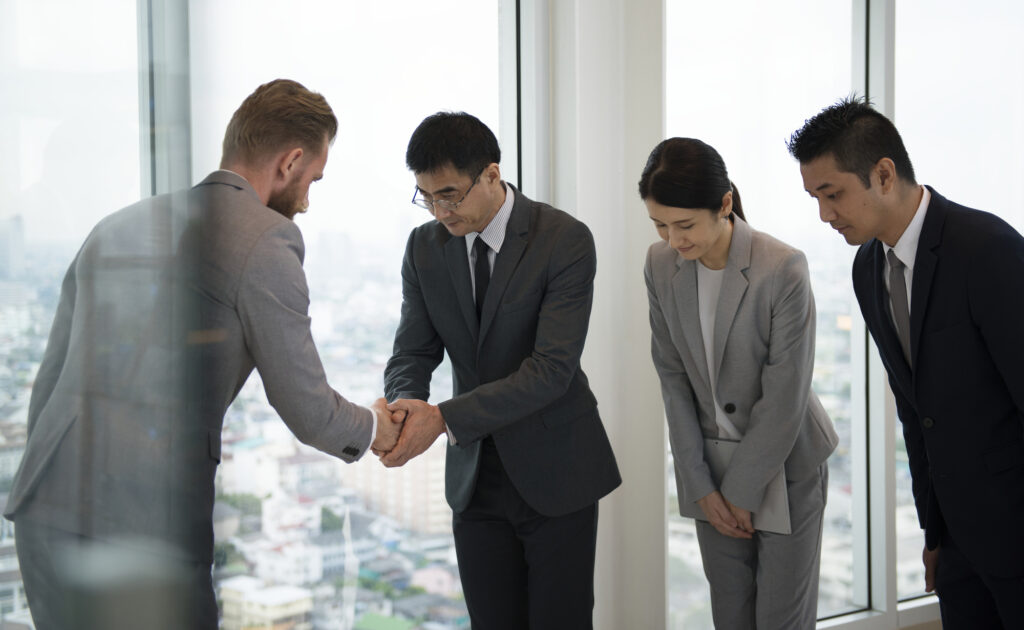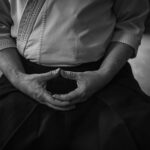For first-time visitors to Japan, knowing where, when and how to bow can be confusing. Etiquette is important to the Japanese people, and while bowing comes naturally to the locals, doing it the right way can be challenging to visitors.
With a little practice and mindfulness, you’ll be able to bow appropriately in any social situation, without even thinking about it. Here’s how to bow in Japanese culture, and what the significance of this respectful action means in the context of different situations.

Why do people in Japan bow?
Bowing, or ojigi, has been customary in Japanese culture since the time of the samurai. As it was then, bowing today is used to signify a wide range of sentiments, including respect, reverence, salutation, apology, gratitude and much more.
Bowing is a big part of modern etiquette in Japan. From everyday greetings to formal business meetings, it’s simply polite to bow in a wide range of everyday social interactions. Here are several everyday social situations where it’s polite to bow, including:
- Greeting someone
- Saying goodbye
- When starting a ceremony, class or meeting
- When expressing gratitude and saying “Thank you”
- Apologizing
- Congratulating someone
- Asking for something
- Worshipping a person, thing or deity
- Showing sympathy or appreciation
- When entering or leaving a martial arts dojo or studio
Different angles of bowing
Not only is the gesture of a bow an important part of Japanese custom, the degree to which you bow is crucial to understand. The angle you bow at represents both the authenticity of your sentiment and the measure of respect you have for the person you’re bowing to. Generally, the deeper the bow and the longer you hold it, the more respect (or submission) you deliver.
Here’s a quick guide to the different angles you might find yourself bowing at while in Japan:
- 15 degrees. This slight bow forward is informal, generally used as a greeting.
- 30 degrees. This is a more formal bow, used to show strong respect to someone else.
- 45 degrees. This is a formal bow, used to clearly demonstrate respect for another.
To put these bows into context, you’re likely to use a 15-degree bow throughout your time in Japan. You’ll use a 30-degree bow in formal settings, such as a tea ceremony or business meeting. You’re unlikely to use a 45-degree bow unless you’ve offended someone and wish to emphatically apologize for your misstep.
Eye contact while bowing
It’s also important to note that eye contact during a bow is considered rude. Look down as you bow as a sign of politeness. A quick tip for those unfamiliar bowing culture is to look at the shoes of the person you’re bowing to for a 15-degree bow, the space between you for a 30-degree bow and your own shoes for a 45-degree bow.
After a bow, it’s considered polite to make eye contact and smile as you shake hands or greet a person. As a rule of thumb, eye contact is considered rude during bows but polite during handshakes. Be sure not to confuse them!
Bowing vs. shaking hands
Bowing isn’t the only polite form of greeting in Japanese culture—shaking hands is appropriate in certain social situations. During first-time interactions, especially in business meetings, it’s polite to shake hands. In some cases, both shaking hands and bowing can take place, especially when people of different nationalities are meeting for the first time. Each culture wants to respect the other, and the two greetings serve as a bridge of respect.
If you’re not sure whether to bow or shake hands when meeting someone in Japan, you can wait until the other person makes the first move. Generally, though, shaking hands is rare in Japan. It’s a more meaningful greeting than it is in the West, symbolizing strong, formal business relationships. If you’re attending a large deal signing or facilitating a high-profile merger, for example, it’s a safe bet you should shake hands with your Japanese counterparts.
How long should you bow?
Contrary to many Western misunderstandings, bowing in Japan isn’t a long, drawn-out ceremonious act. In fact, most bows happen rather quickly. Most bows between two individuals occur over the span of just a few seconds: a gentle tilt forward, a brief stop at the peak of the bow, then a return to an upright position. It should be a meaningful, smooth gesture—not jerky or hurried, which can be seen as a sign of disrespect.
Generally, a person should only hold a bow at the peak when they’re expressing grief or apology. In these instances, you would bend to the apex of the bow, then hold for three to five seconds before rising again. There are also times when holding a bow for a few extra seconds is considered a show of respect, such as when meeting elders or individuals of high rank or office.
A crash course in bowing etiquette
There are three common types of bows in Japanese culture, all performed while standing. For men, keep hands at both sides of your legs when bowing. For women, place one hand on top of the other at the center of your body, just below your abdomen. Here’s how to perform these three common bows the right way:
- Eshaku: The eshaku bow is the most casual type of bow. It’s usually performed by people of the same status or in situations where formalities are less important. For example, when meeting someone by chance in a shop or on the street, the eshaku bow is appropriate. For this bow, drop your upper torso about 15 degrees, looking at the ground a few yards in front of your feet.
- Keirei: The most common type of bow in Japanese business settings, the keirei bow requires you to lower your torso around 30 degrees with your eyes looking at the ground just a few feet in front of the tips of your toes. Use this bow when interacting with superiors at work, entering meetings, greeting clients and any other formal business situations.
- Saikeirei: The saikeirei bow is used to show the utmost respect to another person. When greeting very important people, apologizing or asking for big favors, the saikeirei bow is an appropriate greeting. To perform this bow, dip your torso between 45-70 degrees and stay in the bowed position for a relatively long time to show the highest level of respect and sincerity.
Bowing while sitting or kneeling
The Japanese not only bow while standing—there are also special rules of etiquette to follow when you need to bow while sitting or kneeling. Here’s how to perform these less common, yet still important, bows:
- Zarei: The zarei bow is a seated bow that starts in the formal sitting posture. Usually performed on a traditional tatami floor, you’ll use the zarei bow when participating in traditional activities like tea ceremonies, martial arts, Japanese dancing and more. Zarei bows are further divided into seiza, saikirei, futsurei and senrei.
- Seiza: Start in the sitting position by standing and kneeling down one leg at a time. As you keep the tops of your feet flat on the floor with toes pointed directly behind you, sit on your heels and position your palms on the top of your thighs. Sit up straight, as good posture shows respect.
- Saikirei: Saikirei is the most formal type of sitting bow, ending with your face on the floor. You’ll start in the seiza position, lowering your chest to your lap. As you bow, move your hands along your thighs and rest them on the floor near your knees. Your face should be just inches from the floor in the final position, with your palms on the floor in a triangle configuration. As always, hold your bowing position for an appropriate length to show due respect.
- Futsurei: A common bow for formal situations and traditional activities, the futsurei bow requires you to lower your body until your face is around one foot from the floor. Use your hands to form a triangle on the floor under your face.
- Senrei: The most casual type of sitting bow, senrei bows are polite in many informal situations. Dip your upper body around 30 degrees, sliding your hands down your thights to your knees. Unlike other seated or kneeling bows, only your index finger—rather than your palms—should touch the ground.
Always remember to bow out of respect
The Japanese take etiquette practices like bowing seriously, and as a respectful visitor to the country, you should, too. Don’t assume that you know how to bow properly from watching movies or merely observing! Instead, take the time to learn more about how to bow and why it’s such an engrained part of the Japanese culture of respect.
Get into the practice of bowing often and brush up on bowing etiquette before you visit Japan to enjoy everything this exceptional, unique and respectful culture has to offer. And remember, when in doubt about when or how to bow, default to conscious respectfulness.
- How Much Money Can You Make Teaching English in Japan? - December 12, 2022
- The Best Places to Teach English in Japan - December 9, 2022
- The Best Credentials for Teaching English in Japan - December 8, 2022







